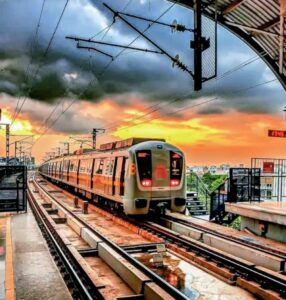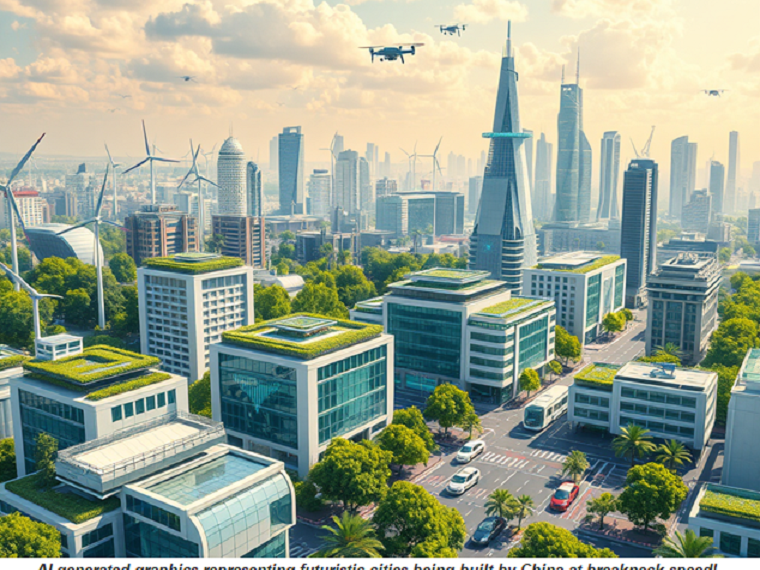Dhanada K Mishra, Hong Kong, 11 October 2025
Recently I visited the southern Chinese city of Guangzhou to attend a trade show and public lecture. Now that I have my five year China travel pass, I can visit China anytime. The travel time was hardly forty minutes by high speed rail from Hong Kong covering a distance of over 171 kms. The city of Guangzhou was stunning in its scale and modern infrastructure. On the way back I came to Shenzhen which is just across the border and a city of modern marvels built in just around 3 decades from a sleepy fishing village. The Pearl river delta which includes cities like Hong Kong, Guangzhou, Macau, Zhuhai, Shenzhen etc. now rivals the famed Silicon valley of the United States in its vibrant economy and innovation and start-up eco-system.
In China you make money by speeding up projects and delivering results; in India, you make money by slowing down progress and creating obstacles. This blunt reality underpins the vast development divide between these two Asian giants—and casts a revealing light on the United States as well. The recent Freakonomics Radio episode “China is Run by Engineers. America is Run by Lawyers.” perfectly captures this leadership contrast: China’s engineers build fast and big, America’s lawyers legislate and litigate endlessly, and India’s bureaucrats wield red tape and approvals as instruments of delay and rent-seeking. It is India’s cumbersome bureaucracy that transforms development into an agonizingly slow and corrupt process.
China’s pace of infrastructure development borders on miraculous. Chinese construction machines can lay 10 to 15 kilometers of expressways daily, with record-breaking tunnel boring machines cutting through underground rock at 50 meters per day, shaving months off project schedules. Countrywide highways and urban metro lines emerge swiftly, powered by leaders trained to see the nation as an engineering challenge demanding practical solutions. China’s infrastructure spending is a well-oiled engine propelling economic growth forward, unhindered by excessive bureaucracy or political gridlock.
By stark contrast, India’s administrative machinery is a knot of colonial-era bureaucracy that thrives on procedure and paperwork. The Indian Administrative Service operates with rigid seniority, minimal performance reviews, and excessive discretionary power for bureaucrats. Decades-long delays plague major projects: the Mumbai-Ahmedabad bullet train, first slated for 2023, now threatens to stretch a decade past deadline with costs nearly doubling due to bureaucratic red tape and land acquisition disputes. The National Highways Authority of India lists over 800 delayed projects, with cost overruns exceeding $56 billion. Every approval, permit, or license becomes a bottleneck—slow progress meets a system incentivizing bribes to grease the wheels.
Beyond delays, this bureaucratic chokehold weakens innovation, discourages investment, and fuels systemic corruption. Small businesses drown in paperwork; foreign investors balk at opaque, inconsistent regulations. Public projects become patronage networks where officials’ unchecked discretionary power facilitates rent-seeking rather than service delivery. Time itself becomes currency, and the longer a project stalls, the higher the informal “speed money” required to move it forward. Unlike China’s engineers who profit by finishing projects faster and America’s lawyers who ensure accountability, Indian bureaucrats profit by holding things hostage.
Yet, India is not without hope or example. The Delhi Metro stands as a beacon of how successful project management can overcome India’s bureaucratic curse. Launched in 1995, the Delhi Metro Rail Corporation (DMRC) was set up as a joint venture between the Government of India and the Government of Delhi, with empowered leadership and clear authority to hire, tender, and manage funds independently. This empowered model allowed the metro project to meet timelines and budgets with remarkable consistency, a rarity in India’s public sector. Phase I, completed within ten years, was widely acclaimed for being on time and within budget, attracting $2.4 billion in development funds and stakeholder cooperation unmatched by other infrastructure projects.

The secret behind DMRC’s success lies in its project management culture: clear accountability, detailed advance planning, stakeholder alignment, and decision-making authority concentrated in capable hands. The corporation maintained transparency, coordinated across multiple agencies, and adhered strictly to schedules—showing that India can do big infrastructure well when bureaucracy is streamlined and professionalized. The Delhi Metro’s daily ridership of over 5 million and its reputation as an urban phenomenon underscore the project’s social and economic impact—an inspiring model to replicate nationwide.
The contrast could not be sharper: China’s engineers get wealthy by speeding up projects, and India’s bureaucrats get wealthy by slowing them down. Bureaucratic delay in India is both a symptom and cause of rampant corruption, a vicious cycle where more approvals mean more graft. While China might bend rules to expedite growth and the U.S. litigates over legal protections, India’s entrenched bureaucracy politicizes and obstructs progress, turning development into a Kafkaesque labyrinth.
For India to truly break out of this trap, it must embrace governance reforms that push power and accountability closer to project execution, foster leadership with clear mandates, and harness modern project management practices exemplified by the Delhi Metro. Without dismantling bureaucratic bottlenecks and the corruption that nests within, India risks forever remaining a country of great potential but disappointing performance—where development is a distant dream delayed by its own officials.
India is making progress in spite of the challenges of all pervasive corruption. One can only imagine how fast the country and its economy can grow if freed from the shackles of corruption by the politician-bureaucrat nexus. A shining example of that is the increasing difference in growth rate and social development indicators achieved by southern states like Tamil Nadu, Kerala and Karnataka compared to their Northern counterparts. We don’t really have to look at China to replicate models that can rapidly propel India to its “Viksit Bharat” goal by 2047.
The takeaway is clear and sobering: Successful nations reward those who build and deliver quickly. In India, the perverse incentive is to hinder and obstruct—and the country pays dearly in lost growth, innovation, and public trust. It is time for India to stop laughing at its bureaucratic absurdity and start engineering a future of efficient, accountable development.







